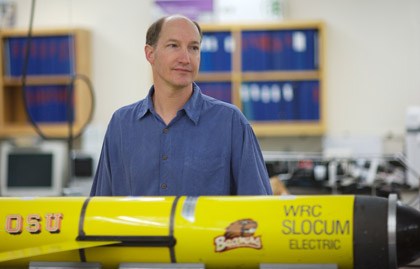Imagine a black box with knobs on the outside that you can turn. If you add fuel, the box produces electricity. By adjusting the knobs, you can change the power output, but there’s a catch — you’re not sure how far to turn the knobs to produce the most power.

For researchers at Oregon State and Portland State, this black box is a microbial fuel cell, a renewable energy source that uses bacteria to convert biodegradable materials, like wastewater, into electricity. And the knobs in this scenario are connected to nanostructures, such as carbon nanotubes. Frank Chaplen and Hong Liu of OSU’s Department of Biological and Ecological Engineering and Jun Jiao of Portland State’s Department of Physics are using nanotubes to boost the power output of microbial fuel cells.
Some evidence in the scientific literature suggests that adding nanostructures to the surface of the fuel cell’s anodes, components on which the bacteria live, could improve the power output, but the researchers didn’t know how or why. Not only that, it’s difficult to control the properties of nanostructures, like width or density. With so many variables to work with, they were struggling to solve their problem in a reasonable amount of time.
This is where Alan and Xiaoli Fern come in. Chaplen asked the couple, who teach in OSU’s School of Electrical Engineering and Computer Science (EECS), to create a mathematical solution. In this case, Chaplen was looking for a mathematical algorithm, a procedure expressed as a set of rules, that would inform the researchers which of the myriad variables would be best to tackle first — in other words, which way to turn the knobs.
Alan Fern is an expert in automated planning and decision theory, which uses computing power to make intelligent decisions about sequential problems. His wife, Xiaoli, specializes in active machine learning, a discipline that aids in identifying the most useful data points for solving a problem.
And so, for the first time, although they have been together since graduate school, the Ferns’ academic interests converged, and they began working on the problem together.
“Traditional research has focused mostly on design problems that have clean, analytical solutions, which require many simplifying assumptions. We come at the problem from a different angle. We start with realistic, messy problems and design algorithms that solve them with raw computing power,” Alan Fern explains.
Mathematical Challenge
They saw the fuel cell project as an opportunity to make a difference, not only for microbial fuel cell research, but for experiments that are difficult to control. For example, in the fuel cell project, instead of requiring an exact density of the nanomaterial, their algorithm could account for a range of densities.
It was just the kind of math-oriented challenge that graduate student Javad Azimi was looking for when he joined the project as a research assistant, helping to design the algorithms and writing the software.
“I really love math, and I like working with real data. So when they told me about it, I said, ‘Yeah, let’s do it!’” Azimi says.
The team set to work on helping Chaplen and Liu find out which nanomaterials (such as gold, iron or carbon nanotubes) and what properties (such as length, width and density) would most likely produce the best power output.
“These statistical models try to capture the researcher’s uncertainty about regions they haven’t explored and take advantage of regions they have explored fairly thoroughly,” Alan Fern adds.
They also performed simulations that can be run repeatedly by a computer. The Ferns and Azimi used this type of modeling to inform decisions about the best experiment to run next and which experiments would be advantageous to run simultaneously, or as computer scientists say, in parallel. Answering such questions saved Chaplen, Liu and Jiao both money and time.
”These experiments are very time consuming, and the researchers can’t afford to run them sequentially, so they have to be in parallel, and we can help them figure out which experiments would complement each other in terms of the information they provide,” Xiaoli Fern adds.
More Electricity
Using this approach, the team was able to successfully identify nanomaterials that enhanced power production by 10 to 20 times. Their efforts were funded by a four-year grant from the Oregon Nanoscience and Microtechnologies Institute in collaboration with the U.S. Army Research Laboratory.
The Ferns and Azimi have also applied their work to data from a project examining hydrogen produced by cyanobacteria, another potential renewable energy source.
In the future, they expect to continue working with the microbial fuel cell team. In fact, they have already submitted another grant proposal, which would help Jiao advance the understanding of nanostructure properties. Nanotechnology has diverse applications in many areas including medicine, electronics and green energy production.
Azimi said that after presenting their research in papers and at conferences he has discovered that it could apply to areas that they hadn’t considered, such as improving the movement of robots.
“Because we are working to solve real problems with our algorithms, I believe the impact of our work will be really high,” says Azimi, who plans to continue this work for his dissertation.




